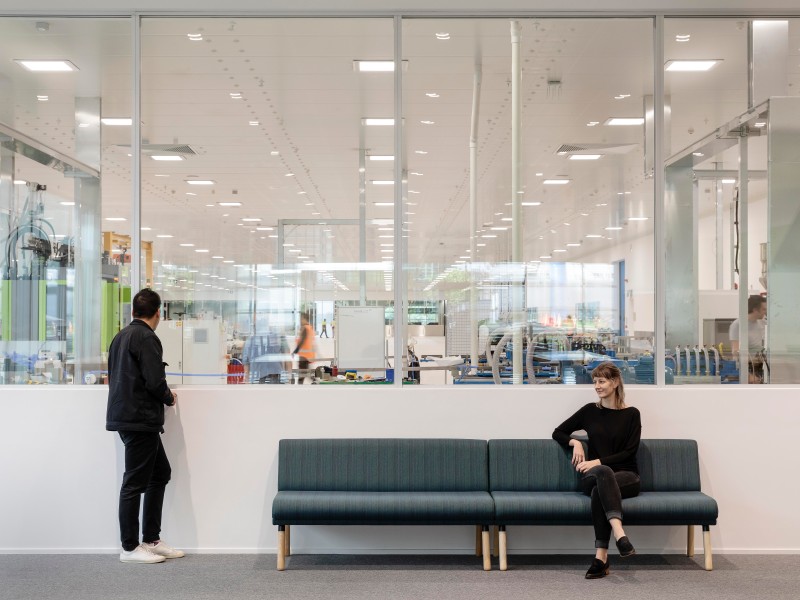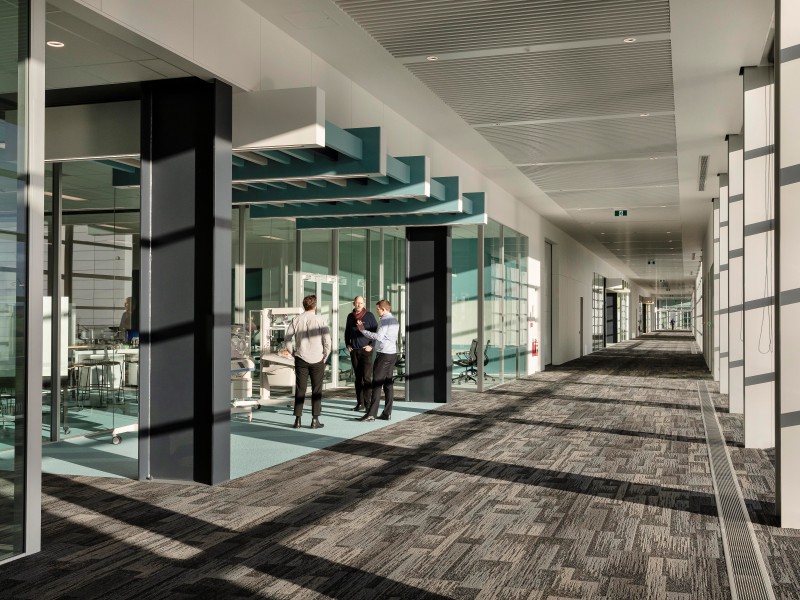Fisher & Paykel Healthcare’s ingenuity in the global marketplace is mirrored in new building
Essentials
Name: Daniell Building
What: Fisher & Paykel Healthcare’s new research, development and manufacturing facility
Who: Fisher & Paykel Healthcare is a global leader of products and systems used in acute and chronic respiratory care, surgery and the treatment of obstructive sleep apnoea
Building details: single-level building covering six hectares, comprises open plan office space, research and development laboratories and model shops, clean room manufacturing facility, materials warehouse, global distribution centre and two cafeterias. The fourth in a series of similarly-formatted buildings at Fisher & Paykel Healthcare’s 40 hectare campus, it is named after the company’s founding CEO Michael Daniell
Where: 15 Maurice Paykel Place, East Tamaki, Auckland
Occupancy: 700 office, research and development employees, 350 manufacturing staff
Project Snapshot
Owner: Fisher & Paykel Healthcare Properties Limited
Architect: Warren and Mahoney
Main contractor: Leighs Construction Ltd
Project budget: $150 million
Project status: commenced November 2017; completed May 2020
Project certification: 5 Green Star Industrial Built v3 (August 2021)

Innovation, precision, people, health and well-being are at the heart of Fisher & Paykel Healthcare’s global business practice.
Now the company has embedded those themes into the fabric of its 5 Green Star rated research and development facility at East Tamaki.
“The Daniell Building demonstrates a finely-tuned, engineered outcome which fits so well with the precision of the medical devices we design and produce. Combined with enhancing the well-being of our team, it’s exactly what we’re about,” says Fisher & Paykel Healthcare’s infrastructure development manager Dale Anthony.
“You can stick people in a box and ask them to work but people won’t be able to work to the best of their ability. We wanted to create a fantastic workplace where our team could thrive and our 5 Green Stars demonstrates what has been achieved. Visitors often walk in and are blown away.”
Dale says when Fisher & Paykel Healthcare embarked on designing and building a new addition to its campus, it saw an opportunity to improve on the past.
While three earlier buildings, the most recent built in 2015, have served the company well, it identified a need to ramp-up energy efficiency across lighting, heating and water consumption.
“We wanted to improve and evolve and achieve better results.”

With Fisher & Paykel Healthcare and Green Star already on the same page – the company has a corporate strategy to reduce its impact on the planet and build more sustainably as part of that - the project targeted a 5 Green Star rating from the outset to drive improvement in building performance.
“Green Star has really been an enabler of change. It challenged us to think outside the square, to do things differently and it helped evaluate the benefits of different energy options. For example our last building had all electric heating but the Daniell Building has two large-scale 850 kilowatt heat pumps. Heating is already six times more efficient than our previous building,” says Dale.
He says the team at Fisher & Paykel Healthcare is proud to have delivered its first Green Star rated building and “the value of our investment is showing with ongoing operational costs almost two thirds lower than the earlier building.”
“The Daniell Building is fresh, innovative and a great work space whilst also being very energy efficient,” says Dale.
Viewed as an exemplar of environmental sustainability, it is underpinned by ‘an energy and environmental strategy to provide a better environnment for its occupants and to minimise its impacts on resources and the environment’ (Green Star certification).
With a vast manufacturing space running the length of the building wrapped with open plan workplaces and common areas, Warren and Mahoney architect Tom Locke says connectivity across the building has been achieved “through the contiguous internal layout and extensive full height internal glazing.”
“The design allows everyone working in the Daniell Building a direct connection with the products being designed and manufactured,” Tom says.

Six central courtyards or garden atriums provide natural daylight deep into the floor plates, each planted with differing native vegetation, reflecting the building’s wider theme of Mountains to the Sea.
He says Warren and Mahoney's design team focused on the well-being of the building’s users and achieving a strong alignment between architecture, structure and services.
“I’m always proud when we can design a building where people feel safe, comfortable, supported and connected to their environment and where we provide them with options to make more sustainable transport choices.”
He says private vehicle transport is a huge contributor to Auckland’s emissions footprint (around 40% of carbon emissions in Auckland are from transport, with around 2 percent from public forms of transport).
“In the Daniell Building we have provided dedicated EV charging spaces, extensive secure bike parking (with drying lines), showers and lockers – all with a high quality of finish. In designing these EOT facilities we have elevated their status by locating them in the most convenient location for access into the building,” says Tom.
GSAP consultant Ella Osborne says during the project “it’s been fantastic to meet with internal groups working to inspire environmental awareness and best practice operational solutions in the Daniell Building such as sustainable transport groups which promote car sharing and the uptake of EVs and a centralized waste sorting facility.”
Ella says Fisher & Paykel Healthcare’s adoption of CopperTree ‘Kaizen’ analytical software demonstrates its dynamic green thinking.
“I understand this powerful data analytics tool has been invaluable and allowed the FPH team to tweak and optimise building performance to achieve energy savings beyond what we have been able to predict via energy modelling during design.”
The issue of striving for optimal performance also applies to waste management during the project with main contractor Leighs Construction recycling over 1000 tonnes of construction waste (around 80 percent) instead of sending it to landfill.
Leighs took its team on a guided tour of waste management subcontractor Green Gorilla’s facility in Onehunga to better understand the practicalities of waste diversion.
“Waste management then became a topic for our site inductions so everyone arriving on site was fully aware of the Green Star requirements,” says Leighs operations manager North Island, Matt Hindle.
He says the Leighs team and subcontractors were also briefed on the Green Star credits being targeted for the project as a whole to ensure wide engagement with the process and upskilling.
Leighs Construction Auckland building services manager, Julie Jenner says the Green Star build has had positive spin-offs.
“Some of the materials credits are now what I would call ‘business as usual’ for both Leighs and our subcontractors such as best practice PVC. Our subcontracting teams gained a great understanding of how to ensure products are actually accredited products giving certainty around the environmental aspects of their material choices.”

Meanwhile the Daniell Building has had a big thumbs up from the Fisher & Paykel Healthcare team.
Senior product development engineer, Larissa Michelsen says on a day to day basis the building’s design fosters excellence.
“At Fisher & Paykel Healthcare we strive for collaboration as it drives better care for our patients. The spacious open plan design of our office spaces in the new Daniell Building facilitates that sense of collaboration and encourages people to connect.
And those chance meetings or snippets of shared insight and creativity, that is what makes all the difference to our final product.”
Larissa says the building’s “great variety of garden atriums provide a relaxing backdrop to moments of reflection and those moments are so important for deep-thinking and wellbeing.”
Fisher & Paykel Healthcare general manager marketing operations, Fiona Cresswell says the building is an uplifting, inviting environment to work in.
“The general vibe of the workspace has a warmth and buzz due to so much natural light and greenery which you see from every workspace and it gives a feeling of being at one with nature. You don’t ever feel you are stuck inside four walls with all the glass and beautiful flora surrounding everywhere,” she says.
Project GSAP consultant Ella Osborne says Fisher & Paykel Healthcare is an organisation that puts people at the heart of everything it does.
“In an era of rapidly accelerating climate change this means ensuring new building developments – like the Daniell Building – will operate with a much lower environmental impact while continuing to deliver innovative, industry-leading products and providing comfortable workplaces for its people.”
Green features include:
|
Technical features include:
Innovation points include:
|
